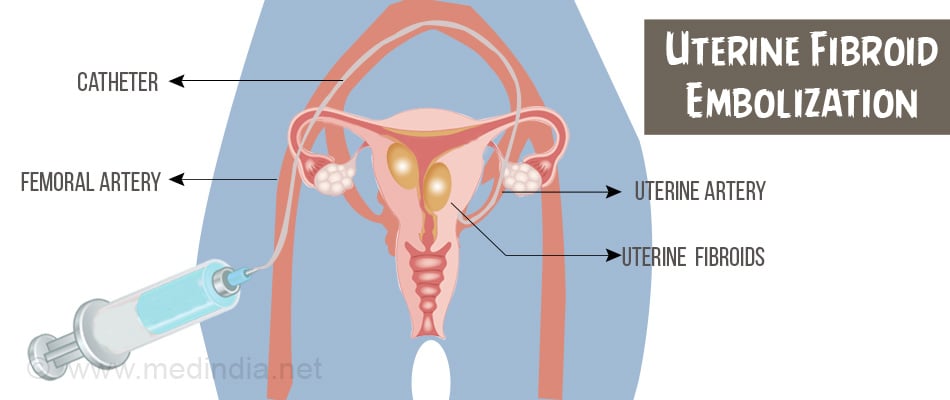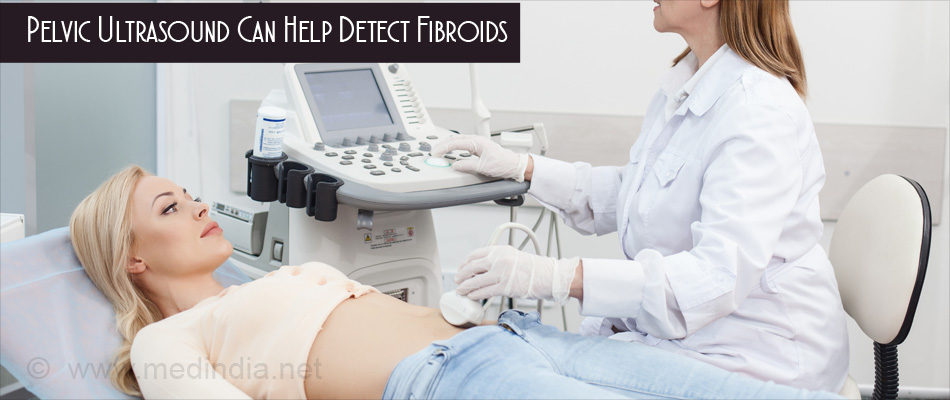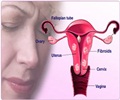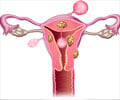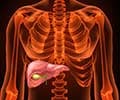What is Uterine Fibroid Embolization (UFE)?
Uterine fibroid embolization is a minimally invasive form of treatment in the therapy of fibroids. The procedure is done by a physician referred to as an Interventional Radiologist who is specially trained to perform such minimally invasive procedures in the uterus and elsewhere.
The patient usually remains conscious, though sedated during the procedure and feels no pain. There is no requirement for general anesthesia unless preferred by the patient or doctor.
The goal of UFE is to cut off the blood supply to the fibroid and cause it to undergo shrinkage and ultimately die.
Fibroids are the most commonly diagnosed benign growths or tumors in the female reproductive tract. They generally occur in the muscle layer of the uterus and are also referred to as leiomyomas. They can range in size from 1-2 mm to huge masses causing uterine enlargement to nearly 5 months pregnant size. There are usually multiple fibroids when they do occur. Depending on their size and location, they can cause
- Heavy menstrual bleeding, especially when the fibroid is abutting the lining of the uterus (endometrium), and occasionally severe enough to cause anemia
- Pain in the abdomen
- Pelvic and back pain, more commonly seen with intramuscular fibroids
- Pain in the legs due to pressure on the nerves supplying the lower limb
- Enlarged abdomen due to a large fibroid
- Painful sexual intercourse
There are various forms of treatment available for managing uterine fibroids. Uterine fibroid embolization or uterine artery embolization is one such newly available form of treatment for fibroids.
- Nearly 20-40 percent of women over the age of 35 years have fibroids causing symptoms.
- UFE procedure to treat fibroids has been done since 1995
- About 20,000 procedures have been performed worldwide, nearly half of them in the US.
- Recently the FDA has approved the use of Embospheres (tiny spherical particles) for injection into the uterine artery to treat fibroids
Uterine fibroid embolization is a non-surgical mode of treatment for fibroids in comparison to surgical forms of treatment such as removal of uterus (hysterectomy) or removal of the fibroid alone (myomectomy).
The possible reason for UFE to prove beneficial in fibroids is because fibroids have an abnormal blood supply together with aberrant response to hypoxia or lack of oxygen.
It is preferred as a treatment option in the following situations:
- Patient is having symptomatic fibroids impacting quality of life
- Patient wishes to keep the uterus
- Surgery is not preferred by the patient or is too risky to undertake
- Patient is not planning any future pregnancies, especially since the knowledge of the effect of UFE treatment on future pregnancy or fertility remains limited.
Other conditions in which uterine artery embolization has been tried with successful outcome include heavy uterine bleeding due to adenomyosis (the lining layer of the uterus or endometrium is abnormally situated in the muscle layer of the uterus) or heavy bleeding following delivery (Postpartum Hemorrhage).
- Diagnostic imaging of the pelvis by ultrasound or MRI is undertaken to confirm the presence of fibroids, their size number and location within the uterus.
![Pelvic Ultrasound Can Help Detect Fibroids Pelvic Ultrasound Can Help Detect Fibroids]()
- Occasionally, the gynecologist might want to directly visualize the uterus by performing a laparoscopy or obtain a sample of the endometrium (biopsy) if there is heavy bleeding between periods, to rule out cancer.
- A complete history regarding medical illnesses, previous surgeries and current medications being taken should be informed to the doctor.
- Presence of any known drug allergies, especially to anesthetic preparations or radiological contrast dyes containing Iodine have to be informed to the doctor.
- Medications such as Aspirin, nonsteroidal anti-inflammatory drugs (NSAID’s) or blood thinners have to be discontinued for a few days before the procedure.
- The patient should inform the doctor if there is a likelihood of her being pregnant as some procedures such as x-ray will not be undertaken due to risk of harm to the fetus.
- Complete physical examination is done to rule out any abnormalities in heart and lungs.
- Blood and urine tests including clotting tests are done before the procedure. An electrocardiogram (ECG) and chest x-ray are also taken as a routine before surgery.
- Patient is advised to take no food or liquid by mouth for at least 8-10 hours before surgery. Any medications advised to be taken on the night before surgery or the morning of surgery have to be taken.
- Before the procedure, any hair on the surgical area is shaved, and the patient is given a sterile gown to wear.
An intravenous line is started to administer sedative medication.
The procedure is performed in the operating room or inside a Cath Lab by the Interventional Radiologist. The entire procedure may last about 90 minutes.
The patient is positioned on the operating table and sedative medication is administered.
The patients vital signs such as heart rate, blood pressure and respiration are continuously monitored by the anesthetist.
The surgical area namely the groin is cleaned with antiseptic solution and draped with sterile surgical cloth.
After infiltrating the area with local anesthetic to numb the skin, a small cut or incision is made at the site. A thin flexible tube called a catheter is inserted into the femoral artery in the groin. The contrast medium is then injected into the catheter. As the contrast flows the patient might feel a warm sensation within.
Using real time x-ray imaging on a monitor (fluoroscopy), the interventional radiologist visualizes the arteries that supply the fibroid.
Once the arteries supplying the fibroid are seen, the doctor injects particles of polyvinyl alcohol or similar material into these vessels via the catheter. As the particles build up in the target area, they cut off the blood supply to the fibroid.
At the end of the procedure, the catheter is removed and pressure is applied over the incision to stop the bleeding. The wound is covered with a dressing and usually no stitches are required.
The intravenous line is removed and patient may be kept in the hospital overnight for observation. Medications for pain relief and sedation will be given. A course of oral antibiotics will be prescribed for prophylaxis against infection.
The patient is usually discharged the following morning with the prescribed pain relief medications and antibiotics.
The patient may experience moderate to severe pelvic pain for 24 hours following the procedure which improves over the next few days.
Occasionally nausea and low grade fever may also be present for a couple of days and medications will be duly prescribed for the same. Usually the patient can resume normal activities within a week or two.
It is not uncommon for vaginal bleeding to occur for a few weeks following the procedure as a fibroid may be breaking down and bleeding. The gynecologist should be consulted right away for further advice and management.
Gradually the menstrual bleeding in the following cycles will reduce and the patient experiences marked relief from the symptoms that were present before the procedure.
Mass-related symptoms such as swelling, back pain and lower limb pain will gradually decrease as the fibroid continues to shrink and die.
Usually in six months’ time, the symptoms stabilize signifying the end of the process and a repeat ultrasound or MRI is performed during the follow-up.
Uterine Fibroid Embolization is a very safe procedure with rate of complications very low. Nevertheless, the following complications have been reported.
- Infection – Though rare, infection following UFE is potentially a life-threatening complication that may occasionally necessitate removal of the uterus (hysterectomy).
- Premature menopause – Unintended embolization of the blood vessels supplying the ovaries might lead to premature menopause, especially in women older than 40 years.
- Cessation of menstrual periods or amenorrhoea
- Formation of scar tissue and adhesions with neighboring tissues in the pelvis with consequent complications.
- Prolonged pain
- Problems in future pregnancies related to placenta attaching to the uterine wall have been reported. Many women have also reported successful pregnancies following UFE. Generally UFE is not preferred in women who wish to become pregnant.
- Occasionally, UFE does not cure the fibroid and patients have had to undergo repeat procedure or a hysterectomy within 5 years.
- Certain insurance schemes may not cover this procedure which is almost as expensive as a hysterectomy.




